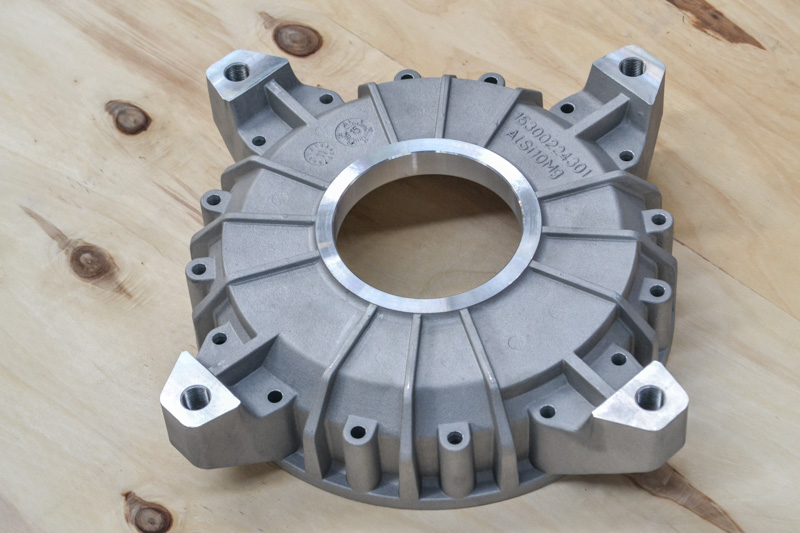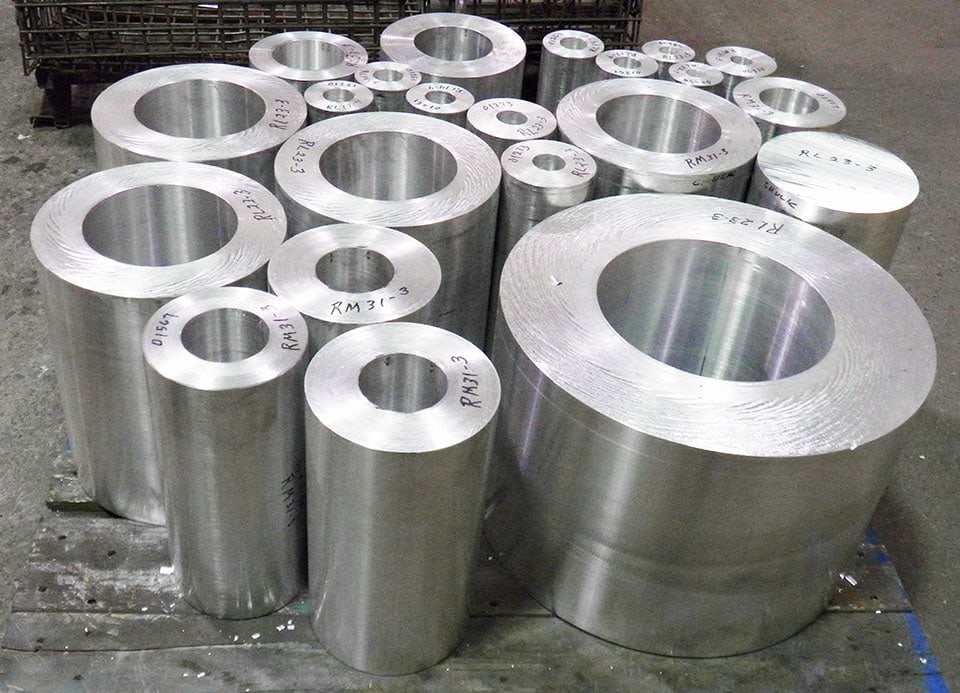The increasing demand for Metal Castings in global markets
Discovering the Advantages and Practical Use Light Weight Aluminum Castings in Today's Market
Aluminum spreadings have actually ended up being progressively relevant in numerous industries because of their unique features. Their lightweight nature and resistance to rust make them appropriate for demanding applications. Furthermore, the exceptional strength-to-weight ratio offers considerable advantages in layout and manufacturing. As sectors remain to explore their potential, the full extent of aluminum spreadings' applications and advantages remains to be completely discovered. What exists in advance for this functional product?
The Lightweight Benefit of Aluminum Castings
Although many products are used in manufacturing, aluminum spreadings stand apart largely as a result of their light-weight residential properties. This characteristic makes light weight aluminum spreadings an appealing selection for numerous sectors, particularly in aerospace and automotive applications, where weight reduction is vital for improving gas efficiency and efficiency. The light-weight nature of light weight aluminum permits makers to develop parts that are much easier to install and deal with, ultimately decreasing labor prices.
Additionally, the capability to create complicated shapes without considerable weight charges makes it possible for developers to introduce while preserving architectural honesty. Light weight aluminum castings can properly change larger materials, causing substantial savings in delivery and functional prices. Their lightweight benefit also contributes to enhanced product durability, as lighter elements often bring about decreased wear and tear on equipment. Generally, the lightweight homes of aluminum spreadings supply makers with a competitive side, promoting innovations in item design and effectiveness throughout various markets.

Exceptional Deterioration Resistance
Aluminum spreadings have an all-natural resistance to oxidation, which significantly improves their longevity in different settings. This inherent building not just adds to their durability yet likewise straightens with the lightweight advantage that aluminum provides. As an outcome, aluminum spreadings are significantly recognized for their outstanding corrosion resistance in countless applications.

Normally Resistant to Oxidation
Among the standout attributes of aluminum spreadings is their extraordinary corrosion resistance, which originates from an all-natural oxidation process. When exposed to air, aluminum reacts to develop a slim, protective layer of aluminum oxide. This layer acts as an obstacle against further oxidation and protects the underlying steel from corrosive aspects such as moisture and salts. Unlike other steels, this oxide layer is self-repairing; if harmed, it promptly reforms when exposed to air. This distinct residential property improves the durability of light weight aluminum spreadings in various atmospheres, making them excellent for applications in markets such as aerospace, vehicle, and marine. The natural resistance to oxidation greatly reduces upkeep prices and boosts the integrity of aluminum castings in requiring problems.
Lightweight Durability Advantage
The light-weight nature of aluminum castings adds substantially to their toughness, making them a beneficial selection in numerous sectors. This extraordinary sturdiness is mostly credited to aluminum's innate resistance to rust, which is enhanced better via anodizing and various other surface area therapies. Unlike lots of steels, aluminum does not corrosion; instead, it creates a safety oxide layer that guards it from ecological damage. This residential property is particularly valuable in sectors such as automobile and aerospace, where weight reduction is critical without compromising stamina. Additionally, the durability of aluminum spreadings decreases maintenance prices and replacements, supplying economic advantages over time. Their lightweight toughness and rust resistance setting light weight aluminum castings as an exceptional product for contemporary manufacturing applications.

Superior Strength-to-Weight Ratio
An amazing quality of aluminum spreadings is their exceptional strength-to-weight ratio, which makes them very desirable in different applications. This inherent property enables light weight aluminum spreadings to hold up against significant stress while remaining light-weight, an essential element in industries such as aerospace, vehicle, and manufacturing. Designers commonly prefer light weight aluminum spreadings for elements that require both longevity and lowered weight, improving fuel efficiency and efficiency.
The high strength-to-weight proportion additionally assists in the style of detailed shapes and frameworks, making aluminum spreadings flexible for facility applications. The capacity to preserve structural integrity under difficult problems guarantees long life and reliability in items, from airplane frames to automobile components. This advantage contributes to the expanding pattern of making use of light weight aluminum spreadings in ingenious styles, eventually leading to improved performance and efficiency across diverse sectors. Consequently, the premium strength-to-weight ratio of aluminum castings positions them as a crucial material in modern-day engineering and manufacturing.
Cost-Effectiveness in Production
Cost-effectiveness in light weight aluminum casting production is primarily accomplished via decreased material waste and effective production processes. By optimizing designs and utilizing innovative methods, producers can decrease excess product usage while preserving quality criteria. This strategy not only reduces manufacturing prices but also adds to much more sustainable practices within the sector.
Decreased Product Waste
Lowering product waste in aluminum casting procedures greatly improves manufacturing performance. By optimizing the layout and production methods, firms can lessen excess scrap and improve source usage. This reduction in waste not just reduces material costs yet likewise adds to an extra lasting production design. The capability to reuse aluminum more supports cost-effectiveness, enabling suppliers to recover and reuse materials without compromising top quality. As the market significantly concentrates on sustainability, decreased material waste aligns with ecological objectives while concurrently improving profitability. Inevitably, efficient use resources enhances the competitive placement of companies out there, making aluminum spreadings a positive choice in numerous applications. The calculated method to lessening waste mirrors a dedication to both financial and environmental duty.
Reliable Manufacturing Processes
While typical manufacturing processes can incur considerable costs, aluminum spreading provides a more reliable alternative that enhances general manufacturing earnings. This method reduces product waste and enables exact control over the production process, bring about reduced labor and operational expenses. The capacity to generate complex shapes with less actions further improves production, contributing to shorter preparations. Additionally, aluminum's lightweight nature and excellent thermal conductivity permit power savings during production and in the last application. By utilizing modern spreading innovations, makers can attain greater throughput without compromising high quality. Consequently, aluminum spreading sticks out as an economical service, making it an appealing option for services aiming to enhance their production procedures in today's open market.
Versatility Throughout Industries
Light weight aluminum castings demonstrate exceptional adaptability throughout numerous industries, as they can be customized to meet particular demands and applications. In the auto sector, aluminum castings are used in engine blocks, transmission real estates, and wheels, supplying lightweight yet durable services that boost fuel efficiency. The aerospace industry also gains from light weight aluminum spreadings, using them in structural parts and engine components as a result of their strength-to-weight ratio.
In the durable goods field, suppliers use light weight aluminum spreadings for items ranging from cookware to furnishings, offering both aesthetic appeal and capability. The electronics market makes use of light weight aluminum spreadings for housings and warm sinks, ensuring reliable thermal administration. In addition, the building sector leverages light weight aluminum castings for building aspects and architectural elements, enhancing resilience and style versatility. This wide applicability highlights light weight aluminum castings as a crucial resource, meeting the diverse needs of numerous markets while preserving high efficiency and reliability.
Sustainability and Environmental Influence
As markets increasingly focus on lasting techniques, aluminum spreadings become an environmentally friendly choice due to their recyclability and low environmental impact. Light weight aluminum is among one of the most recycled products globally, with the capacity to be repurposed multiple times without destruction of top quality. This characteristic substantially minimizes the demand for raw materials and energy usage connected with main light weight aluminum production, which is energy-intensive.
In addition, light weight aluminum spreadings contribute to lightweight layouts, bring about sustain efficiency in transportation applications such as vehicle and aerospace sectors. Their resilience and resistance to corrosion expand product life expectancies, better lessening waste and source use over time. Many makers are taking on liable sourcing and ecologically friendly manufacturing approaches, enhancing the sustainability of light weight aluminum spreading processes. On the whole, light weight aluminum spreadings represent a sensible remedy for businesses intending to reduce their environmental effect while achieving performance and effectiveness.
Technologies in Aluminum Casting Technologies
Recent improvements in aluminum spreading innovations have actually substantially enhanced the efficiency and high quality of production processes. Advancements such as 3D printing and progressed mold-making techniques have made it possible for producers to develop intricate layouts with decreased product waste. This shift not just enhances the precision of actors components yet also shortens lead times, enabling for quick prototyping and faster market entry.
In addition, the consolidation of sophisticated computer simulations aids in anticipating prospective issues throughout casting, leading to higher-quality results (Aluminum Castings). Making use of lightweight alloys has also added to the growth of more powerful, a lot more sturdy items, dealing with sectors ranging from auto to aerospace
In addition, automated spreading processes have actually emerged, minimizing human mistake and raising manufacturing speed. Collectively, these technologies are transforming the aluminum casting landscape, driving better competitiveness and sustainability in manufacturing. As markets continue to develop, these technologies will certainly play an important function in meeting future demands for effectiveness and top quality.
Frequently Asked Concerns
Exactly How Do Aluminum Castings Compare to Various Other Metals in Regards To Thermal Conductivity?
Light weight aluminum spreadings display premium thermal conductivity compared to many metals, such as steel and link iron - Wisconsin Aluminum check out this site Foundry. Their light-weight nature and efficient warm circulation make them excellent for applications needing effective thermal monitoring in numerous industries
What Are the Common Problems Found in Light Weight Aluminum Castings?
Common problems in aluminum castings include porosity, contraction, additions, and surface area abnormalities. These concerns usually develop from incorrect air conditioning rates, insufficient mold style, or contaminations, influencing the general high quality and performance of the end product.
Can Light Weight Aluminum Castings Be Recycled, and How?
Aluminum spreadings can be reused properly. The process involves collecting, melting, and reforming the aluminum, which lessens waste and saves resources. This recycling adds to sustainability while maintaining the material's homes for future usage.
What Are the Typical Lead Times for Aluminum Casting Manufacturing?
Typically, preparations for aluminum spreading production array from 2 to 6 weeks, depending on factors such as complexity, tooling requirements, and production quantity. Effectiveness can improve with well-known distributor relationships and maximized production processes.
Just how Does the Surface Complete Affect Aluminum Casting Efficiency?
The surface area finish significantly impacts aluminum casting efficiency by influencing corrosion resistance, visual high quality, and rubbing features. A smoother surface enhances sturdiness and capability, while a rougher appearance can enhance adhesion for subsequent finishes or therapies.
Many materials are made use see page of in production, aluminum spreadings stand out primarily due to their lightweight buildings. When subjected to air, aluminum responds to form a slim, safety layer of light weight aluminum oxide. Cost-effectiveness in light weight aluminum casting manufacturing is largely accomplished with decreased material waste and effective production procedures. Decreasing product waste in aluminum spreading processes substantially improves production efficiency. Ultimately, efficient usage of raw materials enhances the affordable setting of services in the market, making aluminum castings a desirable option in different applications.